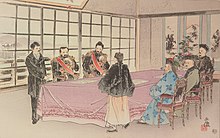Treaty of Shimonoseki
The Treaty of Shimonoseki ( Chinese 馬關條約 / 马关条约 , Pinyin Mǎguān Tiáoyuē ; Japanese 下 関 条約 Shimonoseki Jōyaku or 馬関条約 Bakan Jōyaku ) of April 17, 1895 ended the First Sino-Japanese War . After its defeat, China had to cede several areas (including Taiwan ) to Japan and recognize Korea's independence. The treaty marked the beginning of 50 years of Japanese rule over Taiwan . Because of its one-sided burdens, the peace treaty is counted among the so-called unequal treaties .
prehistory
After the Japanese Empire was able to win the eight-month war thanks to superior military technology and a higher morale of its troops and finally occupied Manchuria and parts of Shandong in the spring of 1895 , the Chinese armed forces surrendered and sought peace. On March 20, negotiations began in the Japanese port city of Shimonoseki (then Akamagaseki, also: Bakan). They were interrupted on March 24 after the attack by a Japanese nationalist on the chief Chinese negotiator Li Hongzhang and only resumed on April 10. On April 17, Count Itō Hirobumi and Mutsu Munemitsu on the one hand and Qing officials Li Hongzhang and Li Jingfang advised by the American diplomat John W. Foster on the other hand signed the agreement in the Shunpanro Hall.
content
In particular, the contract provided for the assignment of Taiwan , the Pescadores Islands and the Liaodong Peninsula in Manchuria to Japan. In addition, China should recognize the “full and comprehensive sovereignty and autonomy of Korea ”, which practically meant the release from vassal status , the loss of Korean tributes and the official loss of the protectorate over the Korean Peninsula . In addition, China undertook to open four further treaty ports (including Chongqing on the upper Yangzi ) for bilateral trade with Japan, in the vicinity of which Japan should also have the right to set up factories and industrial companies.
These finally a war indemnity of 200 million was silver - tael provided what the Qing government corresponded well over twice the total annual income.
consequences
Immediately after the signing of the Shimonoseki Treaty, there were violent protests among Chinese intellectuals. Fundamental economic and political reforms were called for to compensate for the considerable loss of territory and financial outflows, which further weakened the position of the already troubled Qing dynasty . The movement ultimately also influenced the so-called Hundred-Day Reform of 1898, which Emperor Guangxu proclaimed against the will of his powerful aunt Cixi , which remained unsuccessful.
Among the Chinese intellectuals there were also those who saw Japan as a model after the victory, especially after it had also remained victorious against Russia in the Russo-Japanese War of 1904/05. Attempts to modernize China on the model of the Meiji Restoration , however, largely failed. Over 10,000 Chinese students went to Tokyo to get to know Western and already communist ideas. The Japanese capital was to become the nucleus of the impending Chinese revolution.
The immense strengthening of Japan's position associated with the treaty soon called the European foreign powers engaged in China on the scene: as early as November 1895 they forced the island kingdom to renounce the cession of the Liaodong Peninsula in return for an increase in war compensation to 230 million tael ( Intervention by Shimonoseki or triple intervention). In the years that followed, they used the territorial cession enforced in Shimonoseki as a model for their own annexation efforts: between 1897 and 1899, for example, Qingdao fell to the German Empire , Weihai to Great Britain , Liaodong and Lüshun to the Russian Empire and the Zhanjiang region in Guangdong to France .
The treaty laid the foundation for Japan's permanent establishment on the immediate periphery of China. In doing so, he particularly encouraged Japanese aggression in the 1930s, which initially led to the occupation of Manchuria ( Manchuria crisis ) and finally to the outbreak of the Second Sino-Japanese War and the ensuing Second World War in East Asia .
See also
literature
- Jonathan D. Spence : China's Path to Modernity. ( dtv 30795). Updated and expanded edition, Deutscher Taschenbuch-Verlag, Munich 2001, ISBN 3-423-30795-1 .
Web links
Individual evidence
- ^ Alfred Vagts : Germany and the United States in world politics. Macmillan, New York 1935, Vol. 2, pp. 947-958.

